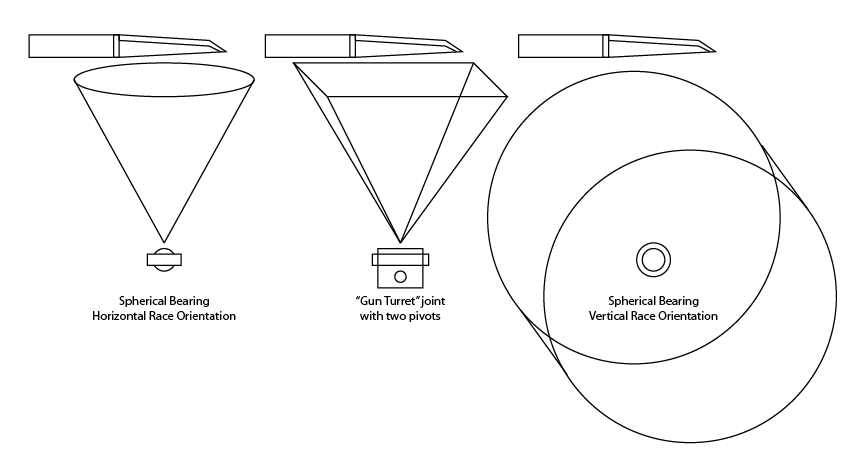- Joined
- Jun 25, 2011
- Messages
- 400
As virtuovice would say, "Hi Knife People!"
I'm fairly new to being a knife enthusiast; I only started about two months ago, so I'm fairly newbie-ish and my collection only has five knives. I got started with being curious about sharpening and advanced steels.
I very much like the ideas behind the WickedEdge sharpening system, as well as the EdgePro, but I can't afford several hundred dollars for a sharpener, so I had fun building one myself.
The sharpener has two orientations, "WickedEdge Mode" and "EdgePro Mode".
Here is the sharpener in "Wicked Edge Mode":
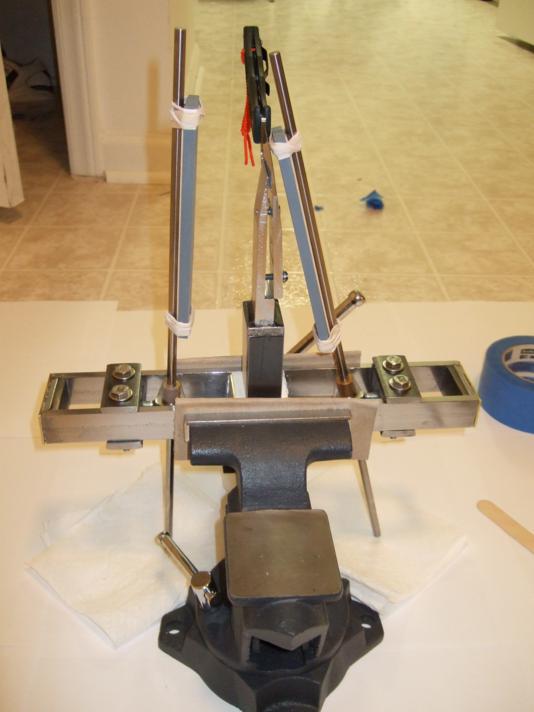
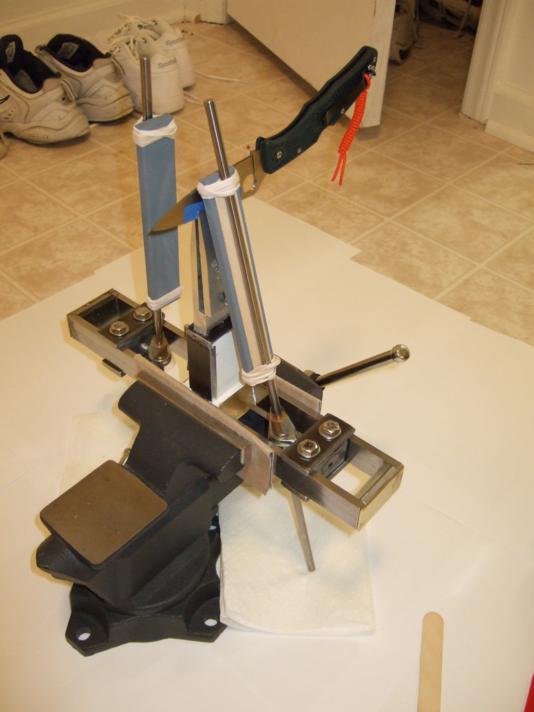


Here is the sharpener in "EdgePro Mode":
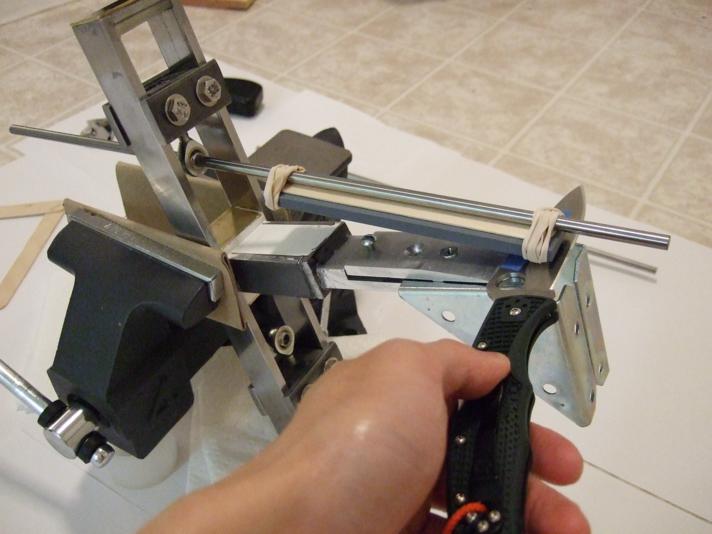
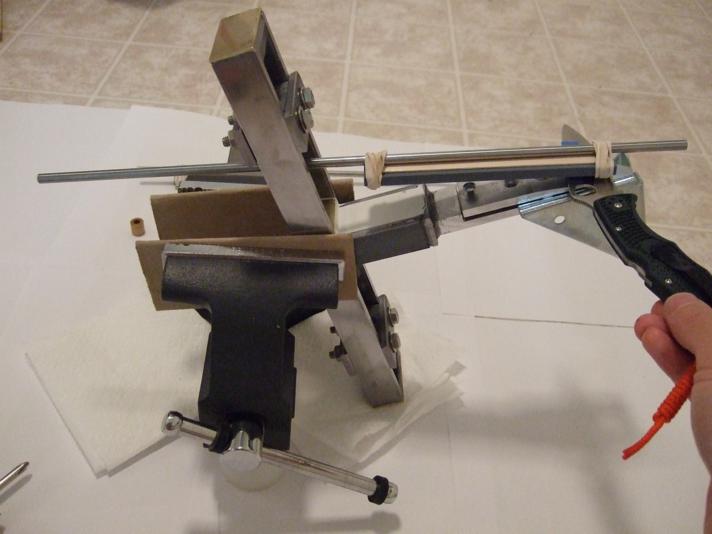
Notice that the rig is basically rotated by about 90 degrees. In this mode, the knife clamp is used to hold a platform, and then the knife can rest on that platform, similar to the EdgePro setup. Right now, this is just a concept test; I still have to build some stuff to make this mode actually work.
One disadvantage of the WickedEdge geometry is that it is difficult to sharpen a knife to less that 15 degrees per side (30 deg inclusive). This is because the knife clamp gets in the way. The EdgePro setup has no clamp, so there is no limitation on how small the sharpening angle can go. I wanted this to experiment with sharpening with extremely small included angles.
For normal sharpening, I like having the knife completely clamped and fixed, and I like the idea of rapidly alternating strokes on each side of the blade, which is why I usually prefer the WickedEdge setup.
By using a 4-inch bench vise, I can change the orientation of the rig, and get which-ever setup I want. At around 10 to 15 lbs, the bench vice is heavy enough to use without mounting/bolting it to a table. The vise is useful for lots of stuff besides sharpening (drilling, sawing, filing, etc.).
More details and photos below, if you are interested. At the end I'll include list of specialized parts and a basic "blue-print" for the setup. Comments and suggestions are welcome; please let me know what you think.
The main mechanical part is a spherical ball joint, which guides the rods. I wanted a fairly rigid setup, so I'm using 1/4" precision ground steel shafts. Here is a sequences of photos for the spherical joint.
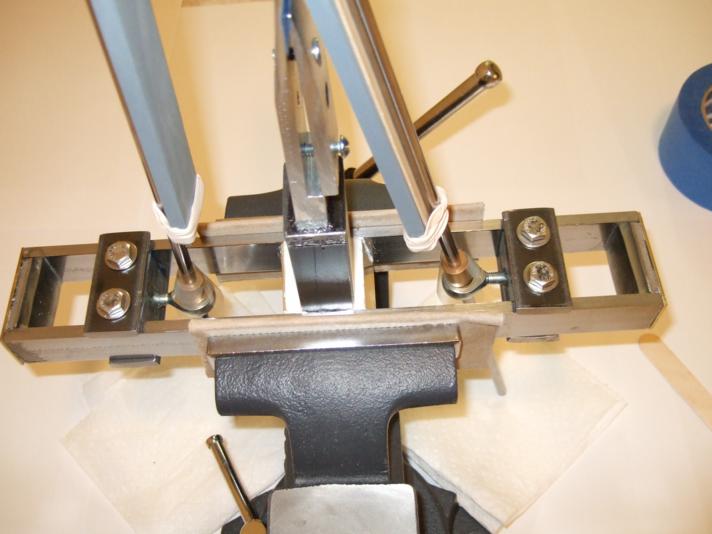

Here is the spherical joint itself. The guide rod slides through the joint and can pivot. The joint is an RBC Heim HM4, which is a "precision spherical joint."
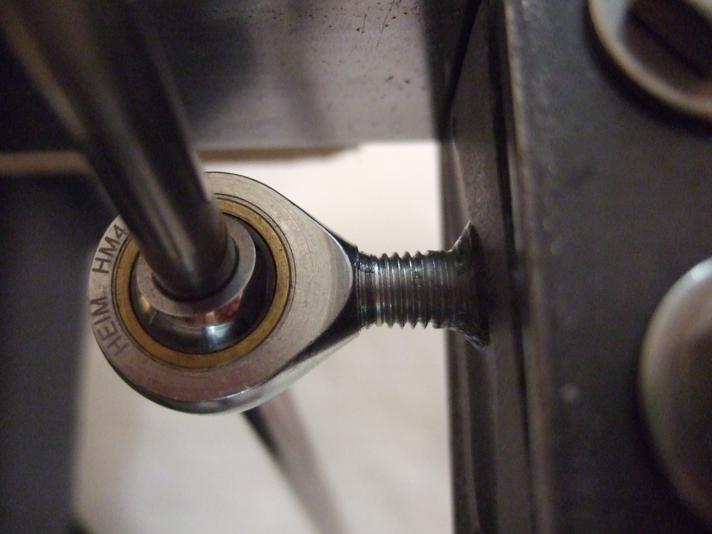
I wanted to protect the spherical joint from ingesting swarf and abrasive particles, so I have shielded it with a sleeve bearing, and a bit of plastic film.


The spherical joint is mounted in a carrier which is clamped to the two side rails using two bolts. Here's the back view of the carrier.
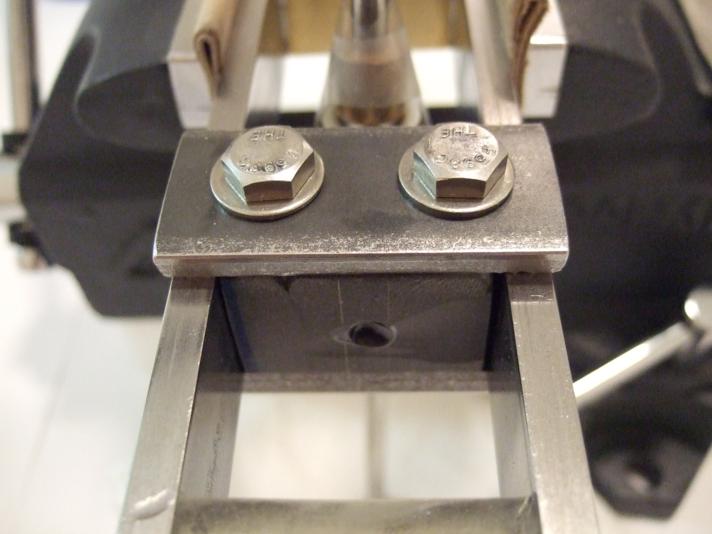

The central pillar is a knife-clamp from a sharpening kit (you can buy the clamp by itself). The knife-clamp has been filed down for sharpening 15 degrees per side. It's mounted on some 1"x1/4" steel bar. The white material in the center is epoxy putty.

The hones are Moldmaster stones from CongressTools.com (recommended by Ankerson). For now, I'm just crudely rubber-banding them to the shafts with a spacer to prevent scratching of the shafts. I'm thinking about how to make a better attachment system for stones, as well as a more ergonomic handle. If you have any ideas, please let me know. I also made some leather strops which I can mount on the shafts (not shown).
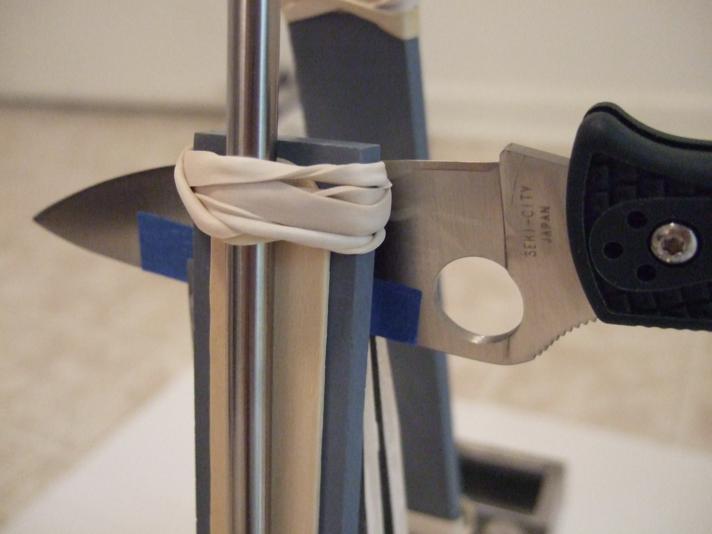
It seems possible to sharpen scissors with this setup, by using a right angle bend in the platform. This is just a concept; I haven't actually built all the parts to try this.

Not really a blueprint, but here's a layout of the design:
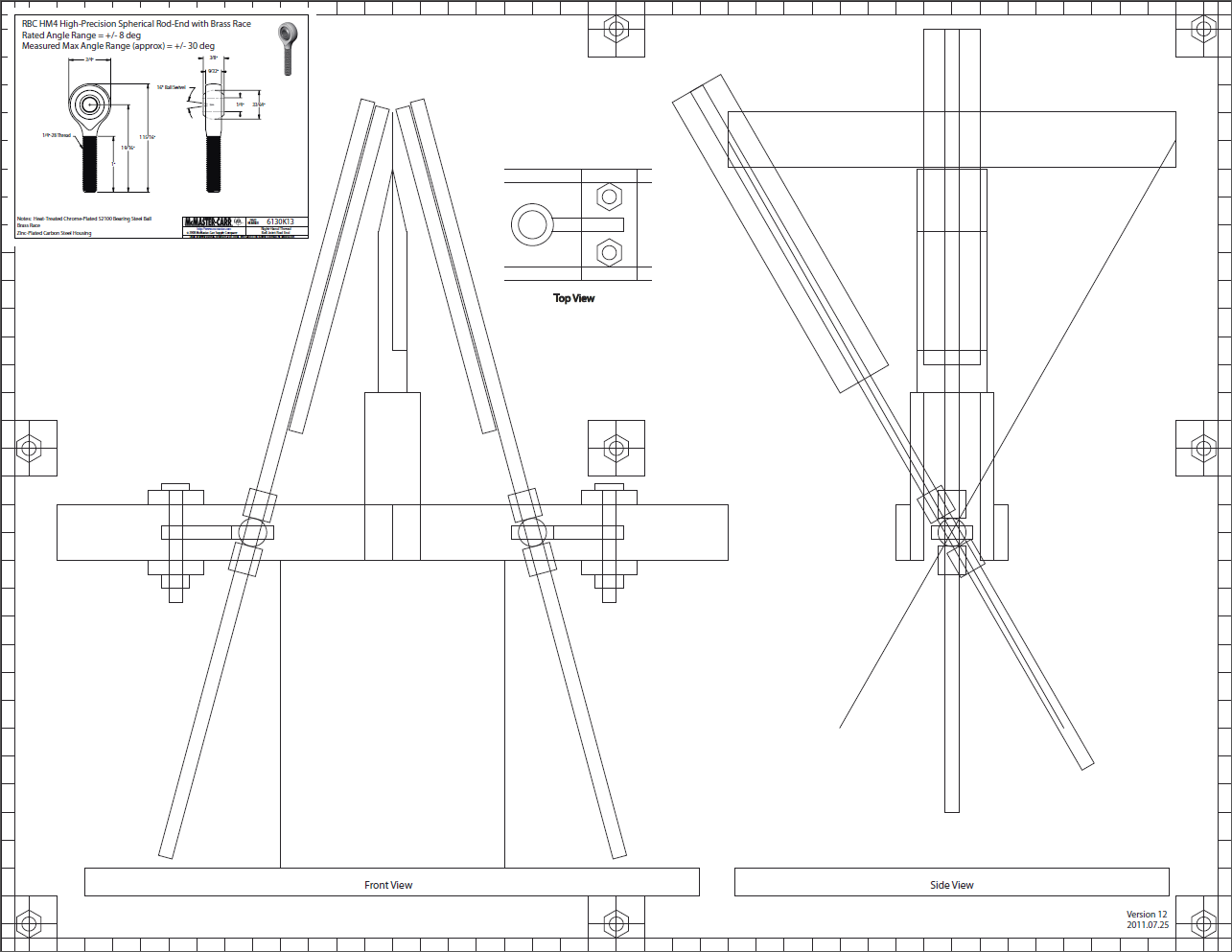
If you're interested in making a similar rig, you can get most of the parts from McMaster.com
Spherical Bearings: $12.22 (each) http://www.mcmaster.com/#catalog/117/1175/=dl0d1r
1/4"Precision Shaft:$ 7.27 (each) http://www.mcmaster.com/#catalog/117/1058/=dl0dk0
Sleeve Bearings: $ 0.81 (each) http://www.mcmaster.com/#sleeve-bearings/=dl0fk4
1"x1/4"x12" Metal bar: $ 7.36 (each) http://www.mcmaster.com/#catalog/117/3634/=dl14ls
1"x1/4"x6" stones: $ 4.00 (each, approx) http://www.congresstools.com/congresstools/catalog?action=getcat&parent=27
4" Bench Vise: $66.30 http://www.mcmaster.com/#bench-vises/=dl0gbe
You should browse through the entire McMaster.com catalog; I did not necessarily choose the best parts. For example, if I had to do it over, I would use 5/16" shafts/joints for additional rigidity, and I would look for stainless steel parts instead of non-stainless.
Most of the assembly I did by using super-glue and super-glue-accelerator to tack the parts together instantly. Then for strength and toughness, I used epoxy and epoxy-putty.
I'll post some additional photos/results once I actually sharpen my Endura 4. On a test knife (not shown), I got hair-whittling sharpness after using the 600 grit Moldmaster stones.
Please let me know what you think; suggestions and comments would be great.
Sincerely,
--Lagrangian
I'm fairly new to being a knife enthusiast; I only started about two months ago, so I'm fairly newbie-ish and my collection only has five knives. I got started with being curious about sharpening and advanced steels.
I very much like the ideas behind the WickedEdge sharpening system, as well as the EdgePro, but I can't afford several hundred dollars for a sharpener, so I had fun building one myself.
The sharpener has two orientations, "WickedEdge Mode" and "EdgePro Mode".
Here is the sharpener in "Wicked Edge Mode":




Here is the sharpener in "EdgePro Mode":


Notice that the rig is basically rotated by about 90 degrees. In this mode, the knife clamp is used to hold a platform, and then the knife can rest on that platform, similar to the EdgePro setup. Right now, this is just a concept test; I still have to build some stuff to make this mode actually work.
One disadvantage of the WickedEdge geometry is that it is difficult to sharpen a knife to less that 15 degrees per side (30 deg inclusive). This is because the knife clamp gets in the way. The EdgePro setup has no clamp, so there is no limitation on how small the sharpening angle can go. I wanted this to experiment with sharpening with extremely small included angles.
For normal sharpening, I like having the knife completely clamped and fixed, and I like the idea of rapidly alternating strokes on each side of the blade, which is why I usually prefer the WickedEdge setup.
By using a 4-inch bench vise, I can change the orientation of the rig, and get which-ever setup I want. At around 10 to 15 lbs, the bench vice is heavy enough to use without mounting/bolting it to a table. The vise is useful for lots of stuff besides sharpening (drilling, sawing, filing, etc.).
More details and photos below, if you are interested. At the end I'll include list of specialized parts and a basic "blue-print" for the setup. Comments and suggestions are welcome; please let me know what you think.
The main mechanical part is a spherical ball joint, which guides the rods. I wanted a fairly rigid setup, so I'm using 1/4" precision ground steel shafts. Here is a sequences of photos for the spherical joint.


Here is the spherical joint itself. The guide rod slides through the joint and can pivot. The joint is an RBC Heim HM4, which is a "precision spherical joint."

I wanted to protect the spherical joint from ingesting swarf and abrasive particles, so I have shielded it with a sleeve bearing, and a bit of plastic film.


The spherical joint is mounted in a carrier which is clamped to the two side rails using two bolts. Here's the back view of the carrier.


The central pillar is a knife-clamp from a sharpening kit (you can buy the clamp by itself). The knife-clamp has been filed down for sharpening 15 degrees per side. It's mounted on some 1"x1/4" steel bar. The white material in the center is epoxy putty.

The hones are Moldmaster stones from CongressTools.com (recommended by Ankerson). For now, I'm just crudely rubber-banding them to the shafts with a spacer to prevent scratching of the shafts. I'm thinking about how to make a better attachment system for stones, as well as a more ergonomic handle. If you have any ideas, please let me know. I also made some leather strops which I can mount on the shafts (not shown).

It seems possible to sharpen scissors with this setup, by using a right angle bend in the platform. This is just a concept; I haven't actually built all the parts to try this.

Not really a blueprint, but here's a layout of the design:

If you're interested in making a similar rig, you can get most of the parts from McMaster.com
Spherical Bearings: $12.22 (each) http://www.mcmaster.com/#catalog/117/1175/=dl0d1r
1/4"Precision Shaft:$ 7.27 (each) http://www.mcmaster.com/#catalog/117/1058/=dl0dk0
Sleeve Bearings: $ 0.81 (each) http://www.mcmaster.com/#sleeve-bearings/=dl0fk4
1"x1/4"x12" Metal bar: $ 7.36 (each) http://www.mcmaster.com/#catalog/117/3634/=dl14ls
1"x1/4"x6" stones: $ 4.00 (each, approx) http://www.congresstools.com/congresstools/catalog?action=getcat&parent=27
4" Bench Vise: $66.30 http://www.mcmaster.com/#bench-vises/=dl0gbe
You should browse through the entire McMaster.com catalog; I did not necessarily choose the best parts. For example, if I had to do it over, I would use 5/16" shafts/joints for additional rigidity, and I would look for stainless steel parts instead of non-stainless.
Most of the assembly I did by using super-glue and super-glue-accelerator to tack the parts together instantly. Then for strength and toughness, I used epoxy and epoxy-putty.
I'll post some additional photos/results once I actually sharpen my Endura 4. On a test knife (not shown), I got hair-whittling sharpness after using the 600 grit Moldmaster stones.
Please let me know what you think; suggestions and comments would be great.
Sincerely,
--Lagrangian
Last edited:



